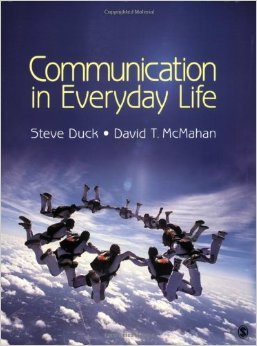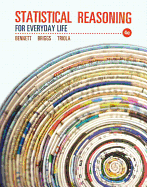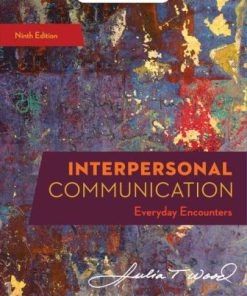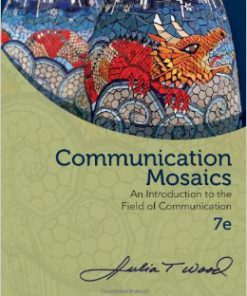Test Bank For Communication in Everyday Life by Steve Duck (Author), David T. McMahan
$35.00 Original price was: $35.00.$26.50Current price is: $26.50.
Test Bank For Communication in Everyday Life by Steve Duck (Author), David T. McMahan
This is completed downloadable of Test Bank For Communication in Everyday Life by Steve Duck (Author), David T. McMahan

Product Details:
ISBN 10: 1412969573
ISBN 13: 9781412969574
Author: David T. McMahan
Communication in Everyday Life is the first survey of communication textbook to explore fundamental concepts, theories, and skills with a thematic integration―the relational perspective―aimed at helping students apply the material to their own lives. This book provides students with a strong foundation in communication concepts, theory, and research, while helping them master practical communication skills, such as listening and critical thinking, using technology to communicate, understanding nonverbal communication, creating persuasive strategies, and managing group conflict. Ideal for 21st-century classrooms, this text provides up-to-date insight into the communication topics students increasingly want and need.
Table of Contents
Chapter 02 Test Bank
True/False
1. In casual relationships, we are more likely to use formal, grammatically correct language.
A) True
B) False
2. In intimate relationships, we use more personal talk.
A) True
B) False
3. We often define concepts by negation, or by explaining what something is not.
A) True
B) False
4. Naming is a relatively unimportant process in framing talk.
A) True
B) False
5. Intentionality is the assumption that messages are produced intentionally and give insight into the sender’s beliefs and thought processes.
A) True
B) False
6. The instrumental function that talk serves in relationships means that talk can make things happen.
A) True
B) False
7. The idea of ‘face’ is something you are only concerned with for yourself and your own image.
A) True
B) False
8. Having more social frames for communication increases uncertainty.
A) True
B) False
Short Answer
9. Explain the difference between de Saussure’s ideas of langue and parole.
10. Explain the connection between naming and thinking expressed by the Sapir-Whorf hypothesis.
11. Explain Kenneth Burke’s concept of God and Devil terms in identifying the hidden values behind words.
12. Explain what your text’s authors mean by ‘conversational hypertext.’
13. Explain the difference between positive and negative face wants.
Multiple Choice
14. The term polysemy refers to:
A) Multiple meanings for the same word
B) Limited meanings for the same word
C) Multiple meanings for multiple words
D) Limited meanings for multiple words
15. The term denotation refers to:
A) Understanding the implications and background behind words
B) The use of language to identify something in a specific or literal way
C) Failing to understand the implications and background behind words
D) The use of language to identify something in a complex and subtle way
16. The term connotation refers to:
A) The use of language to identify something in a simple and straightforward way
B) Failing to understand the implications and background behind words
C) The use of language to identify something in a specific or literal way
D) Understanding the implications and background behind words
17. Understanding someone’s intentions in delivering a message is influenced by:
A) Culture, lack of culture, and acculturation
B) Culture, context, past history and relationship with the other person
C) Context, lack of relational history, and lack of culture
D) Acculturation
18. According to Duck and Pond, talk serves three functions in relationships:
A) Instrumental, polemic, pragmatic
B) Instrumental, expressive, pragmatic
C) Instrumental, indexical, essential
D) Instrumental, essential, minimalist
19. The indexical function of talk in relationships means that:
A) Talk can make something happen
B) Talk can indicate something about the nature or status of the relationship
C) Talk can create the essence of the relationship
D) Talk can terminate the relationship
20. The term ‘facework’ refers to:
A) Managing your ability to smile attractively
B) Managing your public image, dignity, and self-respect
C) Managing your complexion
D) Managing your relationship
21. ‘High form’ in speaking would most likely be:
A) Casual, welcoming and friendly
B) Relaxed and informal
C) Formal and professional
D) Informal and less professional
22. Narratives in relationship talk serve a strategic purpose by:
A) Providing a way to make the conversation more interesting
B) Providing a way to lengthen the conversation
C) Providing a way to summarize the discussion
D) Providing an account or explanation of one’s actions
23. The elements of Burke’s dramatic pentad used to analyze stories are:
A) Scene, agent, method, medium, message
B) Scene, agent, act, actuality, event
C) Scene, agent, act, agency, plot
D) Scene, agent, act, agency, purpose
24. The way that a speaker emphasizes certain elements of the pentad in telling a story can reveal:
A) The person’s perspective on the world
B) The person’s excuses for an event
C) The person’s failure to communicate
D) The person’s ability to deceive
25. Strategies that would help establish the credibility of the speaker/agent delivering a message would include:
A) Choosing not to introduce the speaker
B) Telling slightly embarrassing jokes about the speaker
C) Summarizing the person’s accomplishments
D) Summarizing the person’s limitations
26. Which of the following would not constitute an account of one’s communication?:
A) Lying
B) Justification
C) Excuse
D) Explanation
27. Langue is more likely to be used in:
A) Informal settings
B) Close relationships
C) Formal settings
D) Intimate relationships
28. The element of act in Burke’s pentad refers to:
A) Where it happened
B) Who was involved
C) What happened in time
D) Why something happened
29. The element of agency in Burke’s pentad refers to:
A) Where something happened
B) Who was involved
C) What occurred in time
D) How the act happened
30. The element of agent in Burke’s pentad refers to:
A) Where something happened
B) Who was involved
C) What happened in time
D) How the act happened
31. The element of purpose in Burke’s pentad refers to:
A) Why the act happened
B) Where the act happened
C) Who was involved
D) What happened in time
32. The element of scene in Burke’s pentad refers to:
A) Where the act happened
B) Who was involved
C) What happened in time
D) How the act happened
33. Convergence in talk refers to:
A) People speaking in different styles
B) People indicating distance or disliking
C) People speaking in the same style
D) People avoiding closeness or liking
Chapter 02 Answer Key
1. B
2. A
3. A
4. B
5. A
6. A
7. B
8. B
9. Langue is a term for the formal grammatical structure of language, used when we are in a formal setting or with people we know less well. Parole is usage that is informal and often ungrammatical, used with people with whom we are in a close relationship.
10. The Sapir-Whorf hypothesis proposes that your language and the words you have been taught help you make conceptual distinctions (for instance, Eskimos have more words for snow than you might have because they differentiate between types of snow that have different implications for their daily life).
11. Kenneth Burke believed that God terms are powerful terms viewed positively in a society, and Devil terms are equally powerful terms that are viewed negatively. For instance, God terms in American society might include liberty and freedom, and Devil terms might include terrorism or communism.
12. Conversational hypertext refers to the way that coded messages are included in relationships. These coded messages allow people in the relationship to understand layers of meaning without having to explain them overtly.
13. Positive face wants have to do with the need to be accepted and treated as a worthwhile and valuable person. Negative face wants have to do with the desire not to be imposed upon or treated as inferior.
14. A
15. B
16. D
17. B
18. C
19. B
20. B
21. C
22. D
23. D
24. A
25. C
26. A
27. C
28. C
29. D
30. B
31. A
32. A
33. C
People Also Search:
communication in everyday life by steve duck
communication in everyday life
communication in everyday life by steve duck download scribd
communication in everyday life by steve duck testbank download pdf
You may also like…
Solution Manual
Solutions Manual for Statistical Reasoning for Everyday Life 4e by Jeff Bennett 0321890132
Test Bank
Instructor Manual For Communication in Everyday Life by Steve Duck (Author), David T. McMahan












